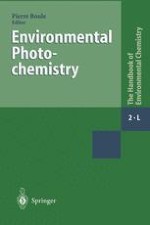1999 | OriginalPaper | Chapter
The Photochemistry of PAHs and PCBs in Water and on Solids
Authors : Richard M. Pagni, Michael E. Sigman
Published in: Environmental Photochemistry
Publisher: Springer Berlin Heidelberg
Included in: Professional Book Archive
Activate our intelligent search to find suitable subject content or patents.
Select sections of text to find matching patents with Artificial Intelligence. powered by
Select sections of text to find additional relevant content using AI-assisted search. powered by
The photochemistry of numerous polycyclic aromatic compounds (PAHs) and polychlorobiphenyls (PCBs) has been studied in water and on solids in environmental and laboratory settings. Photoproducts have been identified in many instances. In the presence of O2, the photochemistry of PAHs is dominated by oxidation, with either singlet O2 or Superoxide serving as oxidant. The factors which dictate whether energy transfer or electron transfer occurs from the PAH excited state to O2 are not well understood. The photochemistry of PCBs in water is dominated by hydrolysis in which Cl is replaced by OH, even in the presence of O2. This is a consequence of the large oxygen-hydrogen bond dissociation energy and dielectric constant of water. Photoisomerization of chlorobiphenyls also occurs in water. On solids the photochemistry of PCBs is different. In the presence of O2, hydrogen is replaced by OH. These reactions appear to involve PCB radical cations. A variety of successful photochemical schemes have been developed, involving solids and water, for the destruction of PCBs. Notable in this regard are the numerous studies on the photocatalytic decomposition of PCBs on TiO2.
